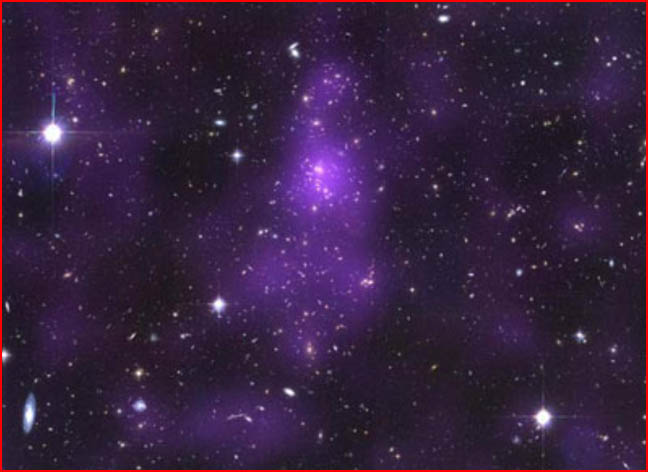
home •
about •
essential guide •
picture of the day •
thunderblogs •
news •
multimedia •
predictions •
products •
get involved •
contact
picture of the day archive subject index
Dr. James Jee from Johns Hopkins University used the Hubble Space Telescope to create a “detailed
map of dark matter concentrations around two galaxies.” But how does “dark matter” work to shape galaxies?
To clarify the concept, NASA scientists have turned to an assortment of less-than-helpful analogies.
Image credit: Jee et al.
Jul 06, 2006
"Baked Galaxies," or Half-Baked Theories?
In the minds of many critics, nothing is more confounding than the language of the popular scientific press release.
Although generally bereft of heavily “technical” wording, the concepts and explanations found in popular scientific media have grown increasingly weird. The weirdness is accentuated when scientists, in an attempt to make their theories “understandable” to the layperson, draw analogies between space and observable “real world” phenomena.
When it comes to weird language and bizarre analogies, it doesn’t get any weirder than the words used to illustrate “dark matter.” In a recent press release, “How to Bake a Galaxy,” NASA/JPL compares galaxy formation to bread baking in an oven. “Start with lots and lots of dark matter, then stir in gas. Let the mixture sit for a while, and a galaxy should rise up out of the batter.”
The report goes on to cite a recent study from NASA’s Spitzer Space Telescope “refining what is known” about dark matter, the so-called “essential ingredient of galaxies.” In the language of NASA scientists, dark matter’s role in galaxy formation is comparable to the role of yeast in bread baking. An absence of enough dark matter means no loaf, e.g. no galaxy.
Study co-author Dr. Jason Surace of NASA's Spitzer Science Center at the California Institute of Technology in Pasadena says of this “baking” process, “Dark matter has gravity, so it pulls in more and more dark matter in addition to ‘normal gas’...We know that the gas eventually condenses into the stars that make up galaxies, but the Spitzer study suggests that this doesn't happen until the dark matter has reached a critical mass."
To Electric Universe proponents -- specialists such as electrical engineers and plasma physicists -- this kind of statement illustrates the seriousness of the 21st century crisis in cosmology. What astronomers envision as inert gas is ionized, radiating plasma, laced with electric (Birkeland) currents. As discussed for the past 2 years on these pages, electrified plasma is an unequaled force at organizing galactic structure. Computer models of two current filaments interacting in plasma have, in fact, reproduced fine details of spiral galaxies. The gravitational schools, on the other hand, must rely on invisible matter, arbitrarily placed wherever it is needed to make their models “work.” Having gravity models appear to work in this manner provides no basis for confidence in them.
The NASA report also features the fundamental error of interpreting an object’s redshift as a reliable indicator of its age and its distance from the observer. The report states, “(Dr. Duncan) Farrah and his colleagues used data from the Spitzer Wide-area Infrared Extragalactic survey to study hundreds of distant objects, called ultraluminous infrared galaxies, located billions of light-years away. These young galaxies are incredibly bright and filled with lots of dusty star-formation activity.”
Astronomer Halton Arp, et al., have studied these objects (given the acronym ULIRGs) extensively. Arp says that acronym should really stand for Under Luminous Infra Red Galaxies, because they are nearby, young and faint; nearby because they appear to have been ejected from those galaxies (and hence have a high intrinsic redshift which astronomers misinterpret as distance), and faint because they have not matured enough to shine with the power of “adult” galaxies.
The scientists’ interpretation of the galaxies’ redshift in the NASA study seems to feature a contradiction. The study’s authors “noticed something weird. For every galaxy they studied, no matter how far away, there seemed to be surrounding dark matter clumps of about the same size. ”
But in the next paragraph, study co-author Surace says, “‘Similar galaxies in our nearby universe form in a completely different way, so what we are learning applies to a different epoch in our universe, far back in cosmic time.’”
The first statement, “no matter how far away,” contradicts the second, that “similar galaxies…nearby…form in a completely different way.” If “how far away” is of “no matter,” then nearby galaxies should not be “completely different.” In a plasma universe, “nearby” includes both old and new galaxies (and of course, no dark matter) so there’s no “different science” operating at different epochs. There is electromagnetism and plasma at all epochs and distances.
The embarrassing analogies do not end with “bread baking” and “whirling lawn sprinklers” in space. Farrah stated of dark matter’s supposed “attractive” powers, “You might think that galaxies are just distributed randomly across the sky, like throwing a handful of sand onto the floor. But they are not, and the reason might be that the dark matter clumps around young galaxies are attracting each other like glue."
Thunderbolts.info editor Mel Acheson neatly summed up the illogic of this reasoning when he stated, “Glue attracts? Perhaps it’s special astronomical glue with extra gravity added. In my experience, glue does not attract, it sticks, much like astronomers’ bond to obsolete theories.”
___________________________________________________________________________Please visit our Forum
The Electric Sky and The Electric Universe available now!

|
|

|
EXECUTIVE EDITORS:
David Talbott, Wallace Thornhill
MANAGING EDITORS:
Steve Smith, Mel Acheson
CONTRIBUTING EDITORS: Dwardu Cardona, Ev Cochrane,
C.J. Ransom, Don Scott, Rens van der Sluijs, Ian Tresman
WEBMASTER: Brian Talbott
Copyright 2006: thunderbolts.info
![]()
home •
thunderblogs •
forum •
picture of the day •
resources •
team •
updates •
contact us

